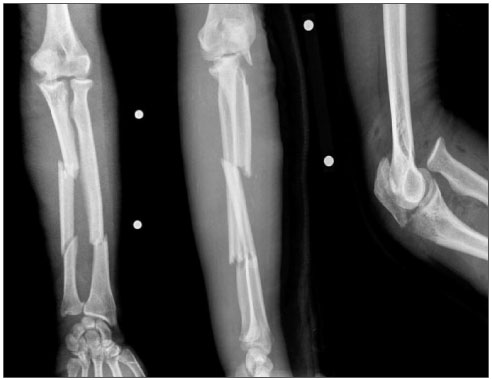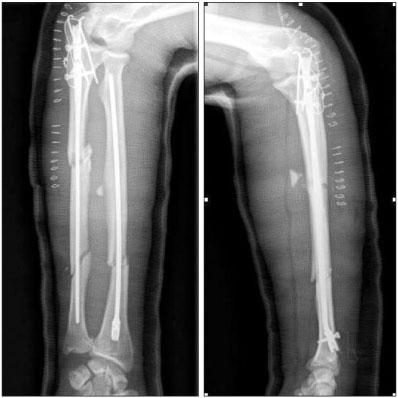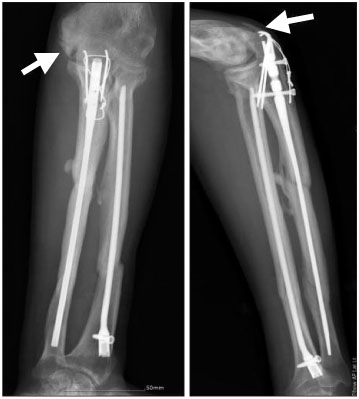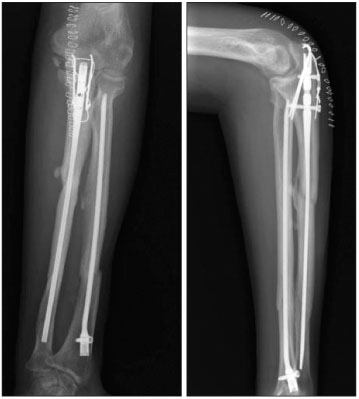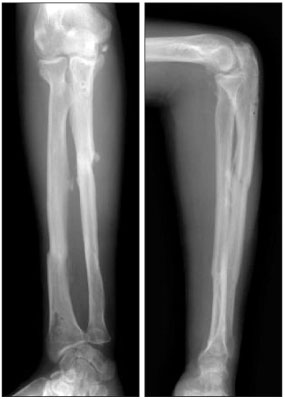J Korean Orthop Assoc.
2010 Dec;45(6):496-500. 10.4055/jkoa.2010.45.6.496.
Treatment of a Segmental Ulnar Shaft Fracture and an Olecranon Fracture
- Affiliations
-
- 1Department of Orthopedic Surgery, Maryknoll Hospital, Busan, Korea.
- 2Department of Orthopedic Surgery, Haedong Hospital, Busan, Korea.
- 3Department of Orthopedic Surgery, Pusan National University School of Medicine, Yangsan, Korea. kuentak@pusan.ac.kr
- KMID: 2185499
- DOI: http://doi.org/10.4055/jkoa.2010.45.6.496
Abstract
- We would like to report a case of treating a segmental fracture of ulnar shaft, with a concomitant olecranon fracture. The patient was treated using tension band wiring and intramedullary nailing procedures. Based on the nature of the olecranon, we believe this should be a recommended treatment method that minimizes complications for the patient that has multiple fractures and a dislocation of the forearm.
Figure
Reference
-
1. Kim BH, Song MH, Ahn SJ, Yoo SH, Lee MS. Multiple fractures of forearm both bones: a case report of 5 separate sites. J Korean Fract Soc. 2005. 18:466–469.
Article2. Morrey BF. Current concepts in the treatment of fractures of the radial head, the olecranon, and the coronoid. Instr Course Lect. 1995. 44:175–185.
Article3. Ahn EH, Lee ST, Koo JH. Operative treatment of diaphyseal fractures of both forearm bones in adults. J Korean Soc Fract. 2001. 14:245–252.
Article4. Anderson LD, Sisk D, Tooms RE, Park WI 3rd. Compression-plate fixation in acute diaphyseal fractures of the radius and ulna. J Bone Joint Surg Am. 1975. 57:287–297.
Article5. Crenshaw AH, Perez EA. Canal T, Beaty JH, editors. Fractures of the shaft of the radius and ulna in adults. 2008. Philadelphia: Mosby;3425–3441.6. Shim JI, Kim TS, Lee SJ, et al. Treatment of diaphyseal fractures of the forearm both bones. J Korean Soc Fract. 2000. 13:1016–1023.
Article7. Lee YH, Lee SK, Chung MS, Baek GH, Gong HS, Kim KH. Interlocking contoured intramedullary nail fixation for selected diaphyseal fractures of the forearm in adults. J Bone Joint Surg Am. 2008. 90:1891–1898.
Article8. Weckbach A, Blattert TR, Weisser Ch. Interlocking nailing of forearm fractures. Arch Orthop Trauma Surg. 2006. 126:309–315.
Article9. Gao H, Luo CF, Zhang CQ, Shi HP, Fan CY, Zen BF. Internal fixation of diaphyseal fractures of the forearm by interlocking intramedullary nail: short-term results in eighteen patients. J Orthop Trauma. 2005. 19:384–391.10. Macko D, Szabo RM. Complications of tension-band wiring of olecranon fractures. J Bone Joint Surg Am. 1985. 67:1396–1401.
Article
- Full Text Links
- Actions
-
Cited
- CITED
-
- Close
- Share
- Similar articles
-
- Tardy Ulnar Nerve Palsy after Olecranon Fracture: 3 Cases Report
- Multiple Fractures of Forearm Both Bones: A Case Report of 5 Separate Sites
- Stress Fracture of Olecranon after Plate Fixation for Osteoporotic Monteggia Fracture with Absence of Radial Head: A Case Report
- Clinical Observation of the Olecranon Fracture
- Tension Band Fixation in the Treatment of the Olecranon Fracture

